3d Sculpture Emphasis Using Isolation 3d Sculpture Harmony Through a Repeating Art Element
If you look at any work of art there will e'er be a focal indicate or signal of emphasis. Utilizing visual accent is one of the most important aspects of an artwork. In this article, nosotros will look at Accent and its role as 1 of the principles in art as well every bit provide a few emphasis art examples.
Table of Contents
- ane What Is Emphasis in Art?
- 2 How to Utilize Accent in Art
- 2.i Contrast
- 2.2 Convergence
- two.three Separation/Isolation
- ii.iv Creation of Exception
- two.v Subordination
- 3 A Summary of Emphasis in Art
- 4 Principles of Art – Further Readings
- v Ofttimes Asked Questions
- 5.1 What Is Emphasis in Art?
- v.2 What Are Examples of Accent in Fine art?
- 5.3 What Are the Principles of Fine art?
What Is Emphasis in Fine art?
Emphasis in art is i of several principles of fine art, which are utilized alongside the elements of art. The latter is described equally your "visual tools", they contain color, form, line, shape, infinite, texture, and value. It is important to non be dislocated with the elements and principles of art, the latter of which use the elements to create a unified limerick.
The principles comprise residue, contrast, emphasis, harmony, movement, pattern/repetition, proportion, rhythm, scale, unity, and variety. These are also described equally a ready of "criteria" that assist in analyzing an artwork from an objective standpoint.
That brings the states to the question, what is emphasis in art? This principle refers to how various elements are applied to depict our, the viewers, attention to a specific focal point. Commonly, there is merely one focal signal, but there can be several in a limerick, every bit we will encounter from the emphasis art examples provided below. However, information technology is encouraged to explore fifty-fifty more than examples of emphasis in fine art in club to understand the myriad of ways this technique can be applied.
There is no one-size-fits-all, and that is what makes this principle so versatile and fun to work with.
How to Apply Emphasis in Art
There are several techniques to utilize to use accent in art, namely, by contrast, convergence, separation or isolation, cosmos of exception, and subordination. We will briefly explain each one below.
Contrast
Creating a contrast between the subject matter will emphasize the focal signal, this can be applied through various elements like colour, value, line, or texture, however, most of the art elements can exist strategically applied to create emphasis in fine art.
Color can exist used in three ways, namely, "complementary", although these are opposites on the color cycle, if positioned adjacent to each other information technology creates emphasis; "isolated" color refers to using one colour that draws attention; and "absent" color refers to the exclusion of virtually colors to emphasize one colour.
An example of utilizing dissimilarity can expect like a bright yellow umbrella in an otherwise grayed limerick. Other examples of Emphasis in visual art include Impression, Sunrise (1872), and Poppy Field (1873) by the Impressionist artist Claude Monet.
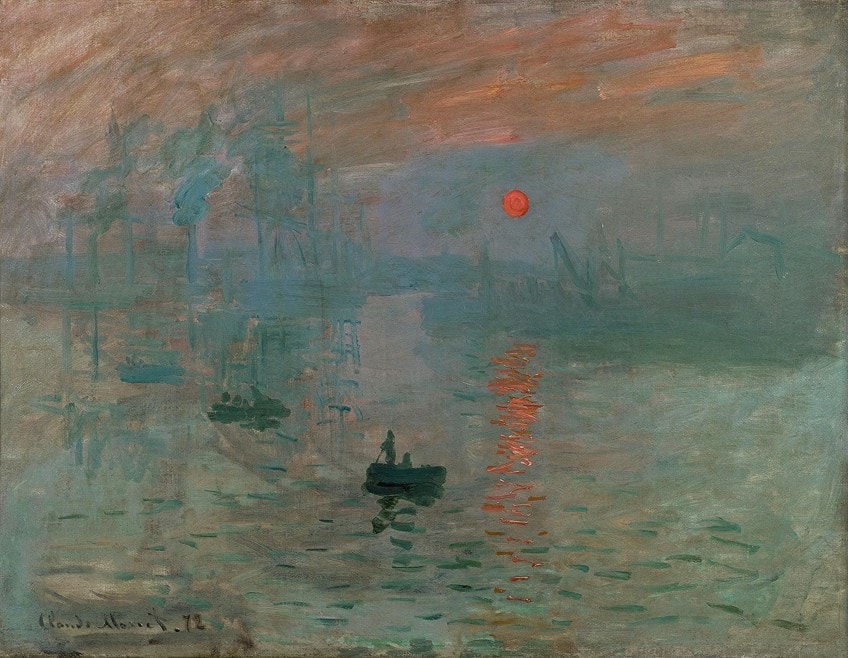 Impression, Sunrise (1872) by Claude Monet;Claude Monet, Public domain, via Wikimedia Commons
Impression, Sunrise (1872) by Claude Monet;Claude Monet, Public domain, via Wikimedia Commons
In the emphasis artwork example above, Impression, Sunrise, we see how Monet created contrast through color and the impression of calorie-free. Our focus is drawn to the brilliant orange of the sun, which is also almost right in the heart of the composition, and the surrounding colors are muted tones of blues, greens, and grays. In Poppy Field, Monet draws our focus to the field of cherry-red poppies to the left-paw side.
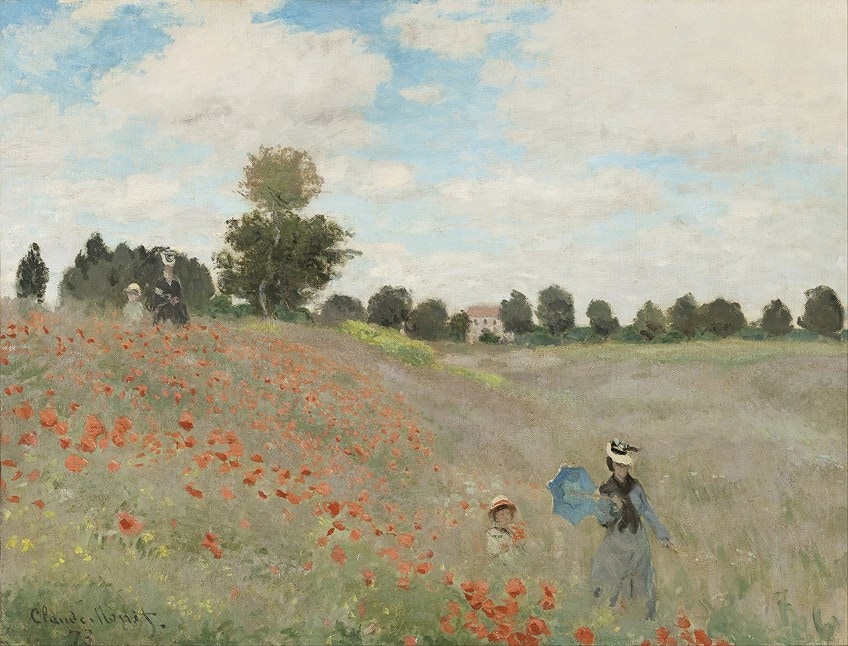 Poppy Field (1873) by Claude Monet; Claude Monet, Public domain, via Wikimedia Eatables
Poppy Field (1873) by Claude Monet; Claude Monet, Public domain, via Wikimedia Eatables
If we expect at the Abstruse artist Mark Rothko, he created large squares of unlike colors on canvas, for instance, Untitled (Red, Blue, Orange) (1955) or Orange and Yellow (1956). Rothko not only created visual accent through his use of contrasting colors on large areas, merely he also created emotional emphasis.
Convergence
Convergence refers to using lines to draw attention to a focal point, which is usually termed the "vanishing signal", this is referred to as linear perspective. Lines can take different lengths and curves that are arranged in specific patterns, repetitions, or sequences that move in ane direction, leading our gaze to what the composition is emphasizing.
There are as well "implied" lines, which just means there are no distinct lines drawing our attention to a focal point, for example, if a effigy looks in a certain direction, our gaze will naturally follow.
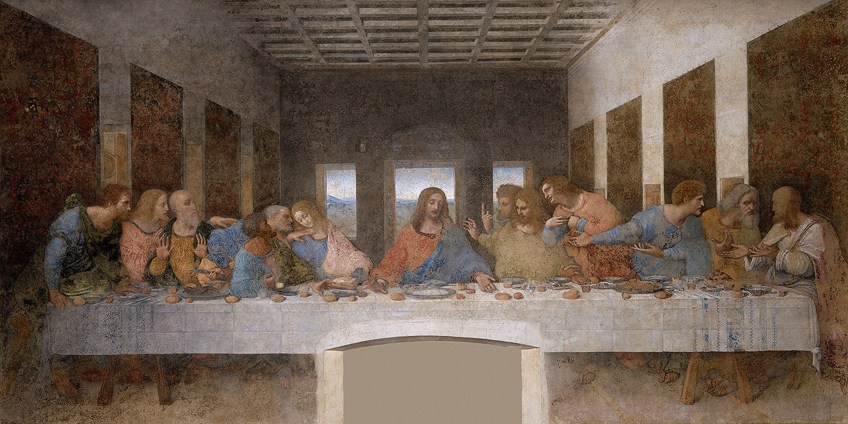 The Last Supper (1495-1498) by Leonardo da Vinci; Leonardo da Vinci, Public domain, via Wikimedia Commons
The Last Supper (1495-1498) by Leonardo da Vinci; Leonardo da Vinci, Public domain, via Wikimedia Commons
An example of emphasis in art through convergence includes none other than The Last Supper (1495-1498) by Leonardo da Vinci. The Renaissance artist was a principal of perspective, and in this painting, he draws our attention to the centralized figure of Jesus Christ, sitting at a table surrounded past the 12 Apostles. Through the convergence of "receding" lines from the surrounding compages, the walls, ceiling, and three windows in the background, the figure of Christ is emphasized.
This technique is also referred to as one-point perspective, with the vanishing point beingness the window behind Jesus Christ'due south head.
Separation/Isolation
Separation or Isolation refers to the placement of the primary discipline matter of artwork as split from the residual of the subject area thing. Past isolating the primary object or subject field it will draw our attention to it equally well as cause united states, the viewers, to question its significance and significant within the greater whole.
Separation or Isolation will single out the main aspects of the artwork.
This can be done by placing a figure away from other figures, or an object, either in the foreground or background or by creating a contrasting event, where the main subject is smaller than the balance of the subject matter or vice versa.
The emphasis artwork case of this technique includes Cristina's Globe (1948) past the American Realist painter Andrew Wyeth. In the foreground we see the solitary female effigy with a vast surface area of a grassy field around her, emphasizing her isolation fifty-fifty more than, and a house in the distance, which is depicted on a smaller scale, also emphasizing the female figure as the main protagonist of the painting.
Creation of Exception
The word "exception" refers to something that is different than the rest or something that does not follow the accustomed rules. For emphasis in art, this will involve depicting the primary subject equally unlike from the rest of the subject matter so that information technology stands out.
This will often appear foreign, out of identify, or unnatural, it is also described as "unusual". Examples can include placing a shape like a triangle amidst circles or placing a flower in between a pavement street crack in an urban setting.
An example of emphasis in art that uses the creation of exception includes the Surrealist painting The Son of Man (1964) by René Magritte. Hither we see the figure of a human wearing an overcoat and a hat, however, what draws our attention is the large green apple covering the man's face.
Another emphasis artwork example includes the German Expressionist Franz Marc's painting titled Large Blue Horses (1911), depicting three big blue horses in the foreground of the painting. The blue emphasizes the horses, a color we would non look for a equus caballus, nonetheless, Marc too creates emotional emphasis hither through his employ of color arrangements.
 Big Blue Horses (1911) by Franz Marc;Franz Marc, Public domain, via Wikimedia Commons
Big Blue Horses (1911) by Franz Marc;Franz Marc, Public domain, via Wikimedia Commons
Subordination
Subordination refers to "de-emphasizing" the bailiwick affair effectually the primary subject to create emphasis on the focal point. This can be done past utilizing fine art elements like color and infinite. For example, the focal point can be in a brighter colour than the rest of the foreground can be in precipitous focus while the background is blurred.
The element of space can refer to the primary subject placed in the foreground on a larger calibration compared to the surrounding field of study matter depicted on a smaller scale. Subordination simply creates a distinction between the primary and "secondary" subjects.
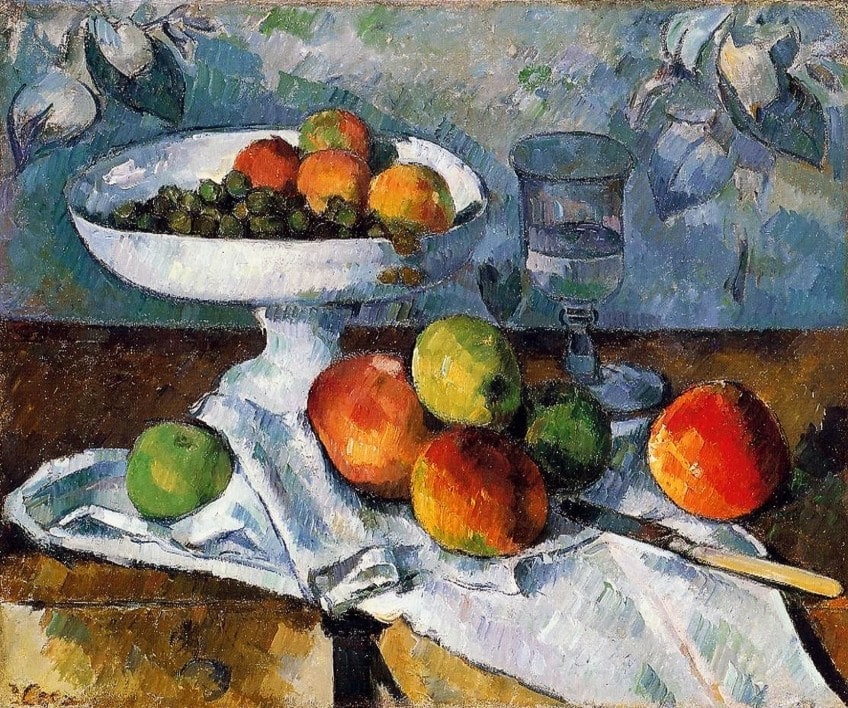 Still Life with Fruit Dish (1879-1880) by Paul Cézanne; Paul Cézanne, Public domain, via Wikimedia Commons
Still Life with Fruit Dish (1879-1880) by Paul Cézanne; Paul Cézanne, Public domain, via Wikimedia Commons
Emphasis fine art examples of subordination include nevertheless lives since their backgrounds are not as meaningful as the forefront, where there are usually baskets with food or like subject affair. One example includes Still Life with Fruit Dish (1879-1880) by Paul Cézanne.
Another accent artwork example is The 3rd of May 1808 (1814) past Francisco Goya, which is depicted by emphasizing the central figure with his hands upward; there is also a light source shining on him, and the other figures are in the shadows, specifically the soldiers, whose backs are towards u.s.a., the viewers.
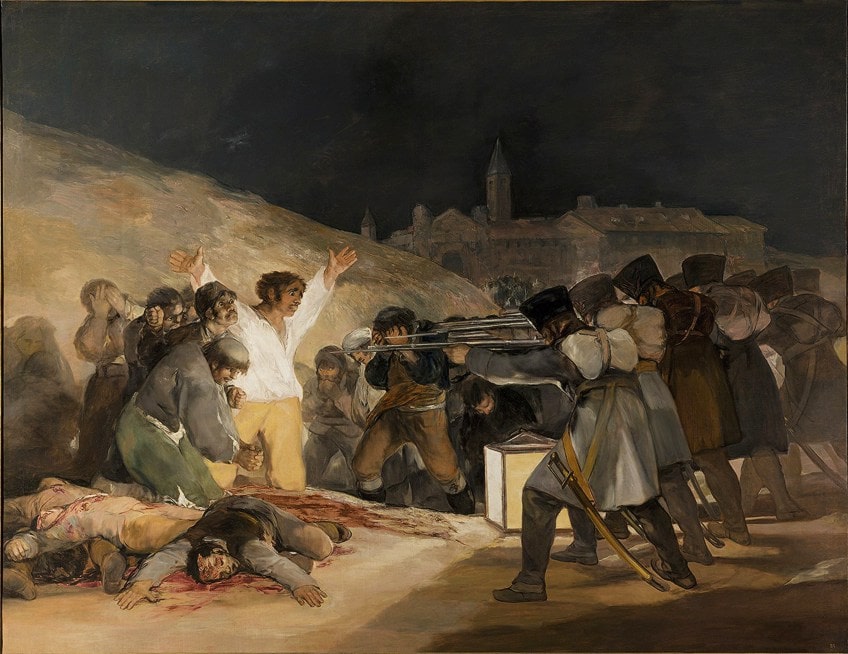 The Third of May 1808 (1814) by Francisco de Goya;Francisco de Goya, Public domain, via Wikimedia Commons
The Third of May 1808 (1814) by Francisco de Goya;Francisco de Goya, Public domain, via Wikimedia Commons
A Summary of Emphasis in Art
| Emphasis in art Techniques | Characteristics | Emphasis Artwork Examples |
| Contrast | To emphasize the focal point in a composition various art elements can exist utilized to create a contrasting effect for emphasis. | Impression, Sunrise (1872) past Claude Monet Blue, Orange, Ruddy (1961) by Mark Rothko |
| Convergence | The utilization of lines to draw viewers' attention to a focal signal or to emphasize a focal point. This is termed linear perspective. | The Terminal Supper (1495 to 1498) past Leonardo da Vinci |
| Separation/Isolation | Refers to the separation or isolation of the main subject field to increase the emphasis. | Cristina's World (1948) by Andrew Wyeth |
| Creation of Exception | The often strange, unnatural, or unusual placement or depiction of the principal bailiwick matter to emphasize it or an idea in the composition. | Bluish Horses (1911) by Franz Marc |
| Subordination | This refers to "de-emphasizing" the subject matter around the main focal point so as to emphasize it. | Still Life with Fruit Dish (1879 to 1880) by Paul Cézanne |
In this commodity, we explored how to create emphasis in art, which is ane of the several principles of art, combined with the various applications of fine art elements, we meet how artworks tin hold many meanings. It is also of import to note that it is not merely visual emphasis created, but through various art elements, emotional and psychological emphasis is also created, particularly when an creative person intends to explore the latter aspects in an artwork.
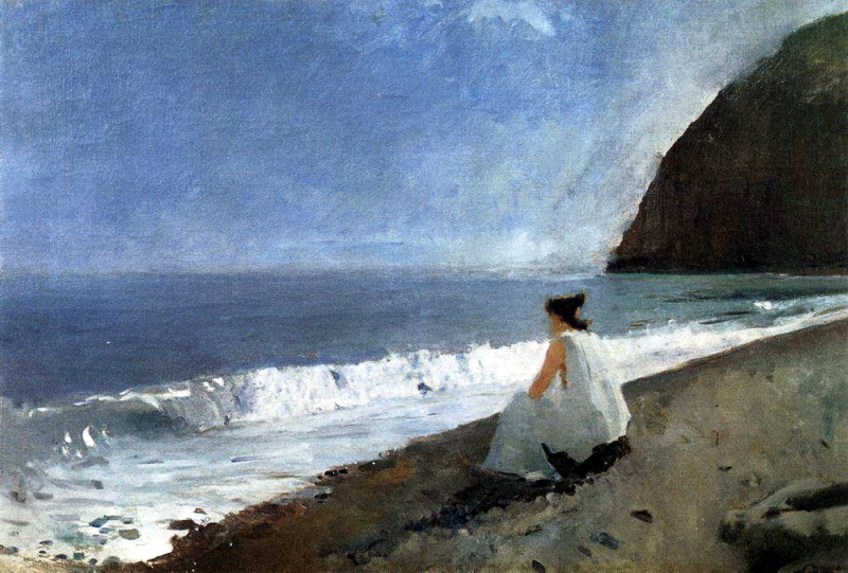 Iphigenia in Tauris (1893) by Valentin Serov. In this painting, the crashing waves create a tapered line that is broken upwards by the woman looking out over the sea. By interrupting the line, the woman emphasizes her position and makes a powerful statement; Valentin Serov, Public domain, via Wikimedia Commons
Iphigenia in Tauris (1893) by Valentin Serov. In this painting, the crashing waves create a tapered line that is broken upwards by the woman looking out over the sea. By interrupting the line, the woman emphasizes her position and makes a powerful statement; Valentin Serov, Public domain, via Wikimedia Commons
Commonly, what creates emphasis in art is contrast, which can exist conveyed in numerous ways, be it through colour compositions, textures, size, scale, or infinite, among others. Other techniques that create emphasis include convergence, separation or isolation, creation of exception, and subordination, techniques portrayed in only a few of the emphasis art examples mentioned to a higher place.
Principles of Fine art – Farther Readings
- Principles of Fine art main article
- Move in Art
- Unity in Art
- Rhythm in Art
- Texture in Art
- Proportion in Art
- Balance in Fine art
- Harmony in Art
Equally we take seen from the examples of emphasis in art above, it is an of import principle of art that, without it, we would exist staring at a meaningless composition. Utilizing the diversity of tools at our dispensable, and strategically applying these, we, every bit artists, can create meaningful and monumental artworks. Additionally, understanding how accent in art works we are also better equipped to clarify all the important paintings and sculptures from throughout the ages, which will ultimately refine their meaning for united states of america. Therefore, by understanding emphasis, we tin can speak the language of meaning in art.
Ofttimes Asked Questions
What Is Emphasis in Art?
Accent in art is part of the principles of art, information technology is about drawing attending to the principal subject field thing in the composition through the application of diverse art elements like color, line, texture, space, shape, course, and value.
What Are Examples of Emphasis in Fine art?
Emphasis in art tin be utilized in unlike ways, namely through convergence, isolation or separation, creation of exception, subordination, or contrast.
What Are the Principles of Fine art?
The principles of art are a set of rules or techniques that act every bit criteria when composing artworks, be it paintings, drawings, or sculptures. These are contrast, variety, harmony, rhythm, scale, balance, movement, pattern or repetition, unity, and emphasis.
0 Response to "3d Sculpture Emphasis Using Isolation 3d Sculpture Harmony Through a Repeating Art Element"
Post a Comment